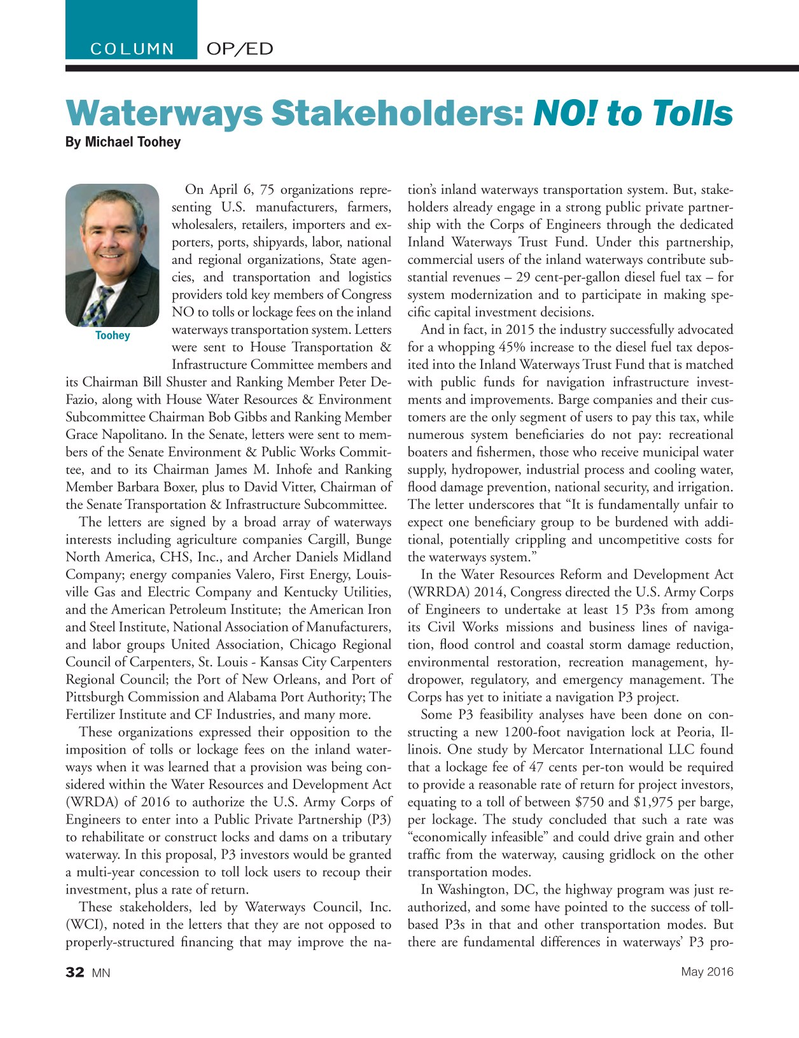
Page 32: of Marine News Magazine (May 2016)
Inland Waterways
Read this page in Pdf, Flash or Html5 edition of May 2016 Marine News Magazine
COLUMN OP/ED
Waterways Stakeholders: NO! to Tolls
By Michael Toohey
On April 6, 75 organizations repre- tion’s inland waterways transportation system. But, stake- senting U.S. manufacturers, farmers, holders already engage in a strong public private partner- wholesalers, retailers, importers and ex- ship with the Corps of Engineers through the dedicated porters, ports, shipyards, labor, national Inland Waterways Trust Fund. Under this partnership, and regional organizations, State agen- commercial users of the inland waterways contribute sub- cies, and transportation and logistics stantial revenues – 29 cent-per-gallon diesel fuel tax – for providers told key members of Congress system modernization and to participate in making spe-
NO to tolls or lockage fees on the inland ci? c capital investment decisions.
waterways transportation system. Letters And in fact, in 2015 the industry successfully advocated
Toohey were sent to House Transportation & for a whopping 45% increase to the diesel fuel tax depos-
Infrastructure Committee members and ited into the Inland Waterways Trust Fund that is matched its Chairman Bill Shuster and Ranking Member Peter De- with public funds for navigation infrastructure invest-
Fazio, along with House Water Resources & Environment ments and improvements. Barge companies and their cus-
Subcommittee Chairman Bob Gibbs and Ranking Member tomers are the only segment of users to pay this tax, while
Grace Napolitano. In the Senate, letters were sent to mem- numerous system bene? ciaries do not pay: recreational bers of the Senate Environment & Public Works Commit- boaters and ? shermen, those who receive municipal water tee, and to its Chairman James M. Inhofe and Ranking supply, hydropower, industrial process and cooling water,
Member Barbara Boxer, plus to David Vitter, Chairman of ? ood damage prevention, national security, and irrigation. the Senate Transportation & Infrastructure Subcommittee. The letter underscores that “It is fundamentally unfair to
The letters are signed by a broad array of waterways expect one bene? ciary group to be burdened with addi- interests including agriculture companies Cargill, Bunge tional, potentially crippling and uncompetitive costs for
North America, CHS, Inc., and Archer Daniels Midland the waterways system.”
Company; energy companies Valero, First Energy, Louis- In the Water Resources Reform and Development Act ville Gas and Electric Company and Kentucky Utilities, (WRRDA) 2014, Congress directed the U.S. Army Corps and the American Petroleum Institute; the American Iron of Engineers to undertake at least 15 P3s from among and Steel Institute, National Association of Manufacturers, its Civil Works missions and business lines of naviga- and labor groups United Association, Chicago Regional tion, ? ood control and coastal storm damage reduction,
Council of Carpenters, St. Louis - Kansas City Carpenters environmental restoration, recreation management, hy-
Regional Council; the Port of New Orleans, and Port of dropower, regulatory, and emergency management. The
Pittsburgh Commission and Alabama Port Authority; The Corps has yet to initiate a navigation P3 project.
Fertilizer Institute and CF Industries, and many more. Some P3 feasibility analyses have been done on con-
These organizations expressed their opposition to the structing a new 1200-foot navigation lock at Peoria, Il- imposition of tolls or lockage fees on the inland water- linois. One study by Mercator International LLC found ways when it was learned that a provision was being con- that a lockage fee of 47 cents per-ton would be required sidered within the Water Resources and Development Act to provide a reasonable rate of return for project investors, (WRDA) of 2016 to authorize the U.S. Army Corps of equating to a toll of between $750 and $1,975 per barge,
Engineers to enter into a Public Private Partnership (P3) per lockage. The study concluded that such a rate was to rehabilitate or construct locks and dams on a tributary “economically infeasible” and could drive grain and other waterway. In this proposal, P3 investors would be granted traf? c from the waterway, causing gridlock on the other a multi-year concession to toll lock users to recoup their transportation modes.
investment, plus a rate of return. In Washington, DC, the highway program was just re-
These stakeholders, led by Waterways Council, Inc. authorized, and some have pointed to the success of toll- (WCI), noted in the letters that they are not opposed to based P3s in that and other transportation modes. But properly-structured ? nancing that may improve the na- there are fundamental differences in waterways’ P3 pro-
May 2016
MN 32
MN May16 Layout 18-33.indd 32 4/20/2016 2:01:18 PM

 31
31

 33
33
